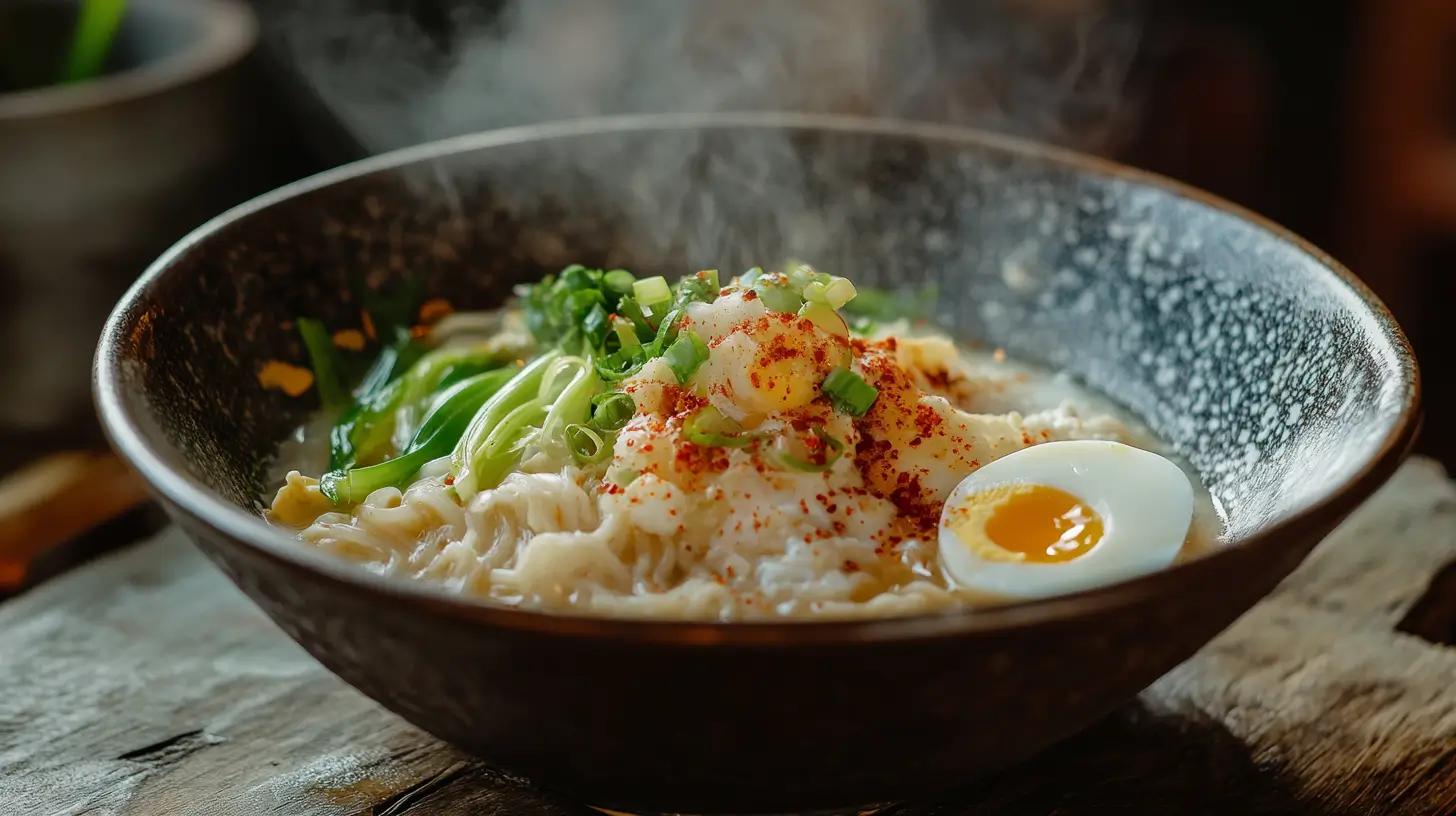1: What is Asian Noodle Soup?
Origins and Cultural Significance
Asian noodle soup isn’t just a dish — it’s a symbol of comfort, tradition, and regional pride. Across Asia, noodle soups have evolved over centuries, deeply rooted in the culinary customs of countries like China, Japan, Vietnam, Thailand, and Korea. From humble street-side vendors to five-star restaurants, these soups offer more than flavor — they represent heritage, healing, and home.
Table of Contents
Common Ingredients Found in Asian Noodle Soups
Though recipes vary, most Asian noodle soups begin with a flavorful broth, noodles (egg, rice, or wheat), a protein (like chicken, beef, or tofu), and a variety of vegetables. Key aromatics include ginger, garlic, scallions, and soy sauce. Seasonings like sesame oil, fish sauce, and chili paste bring each region’s flair to life.
Asian Noodle Soup vs. Western Soups
Unlike creamy Western soups, Asian noodle soups are broth-based, emphasizing balance and clarity of flavor. The noodles serve as a main feature, making the dish both hearty and light.
2: Types of Asian Noodle Soups Around the World
Japanese Ramen, Udon & Soba Soups
Japan offers a delicious trifecta when it comes to noodle soups: ramen, udon, and soba. Ramen is known for its rich, often pork-based broth and springy wheat noodles. Udon features thick, chewy noodles in a lighter soy or dashi-based broth, while soba uses buckwheat noodles in both hot and cold variations. Each has regional spin-offs that elevate local ingredients.

Chinese Noodle Soups: Egg Noodles, Wonton Soup, Hot and Sour Soup
Chinese noodle soups range from the clear and savory to the bold and spicy. Classic choices include egg noodle soups with bok choy and chicken, wonton soup with shrimp dumplings, and the tangy hot and sour soup that gets its kick from vinegar and white pepper.
Vietnamese Pho and Hu Tieu
Pho is Vietnam’s national treasure — a beefy broth simmered for hours, poured over rice noodles, thin beef slices, and herbs. Hu Tieu, another popular Vietnamese noodle soup, is lighter but equally flavorful, often featuring pork and seafood.
Thai Tom Yum and Boat Noodles
Thailand’s contributions include Tom Yum noodle soup, a tangy, spicy bowl infused with lemongrass, galangal, and lime. Boat noodles are rich and complex, sometimes incorporating beef blood to deepen flavor.
Korean Jjampong and Ramyeon
Jjampong is a spicy seafood noodle soup with chewy noodles and fiery red broth. For a quick fix, ramyeon (Korean-style instant ramen) is a beloved comfort food, often dressed up with eggs, kimchi, and vegetables.
3: Key Elements of a Flavorful Asian Soup Broth
Foundational Broths: Chicken, Pork, Beef & Vegetable Stocks
At the heart of every great Asian noodle soup lies a deeply flavorful broth. Traditional bases include slow-simmered chicken, pork, or beef bones, which create rich, collagen-packed liquids. Lighter soups may use vegetable stock, ideal for vegan or gluten-free versions.

The Secret Seasonings: Soy Sauce, Sesame Oil, Ginger, and Chinese Cooking Wine
It’s the seasoning that brings the broth to life. Soy sauce adds salt and umami, while sesame oil provides nuttiness. Ginger and garlic infuse warmth and spice. A splash of Chinese cooking wine (or dry sherry) adds depth and complexity — a secret weapon in many restaurant-style broths.
How to Balance Sweet, Salty, Spicy, and Umami Flavors
Asian cuisine is all about balance. A spoonful of sugar or mirin softens saltiness. Chili oil or fresh chili brings the heat. Fish sauce or miso pumps up umami. Mastering this balance is key to creating a broth that’s soulful, not just salty.
4: Types of Noodles Used in Asian Soups
Egg Noodles, Rice Noodles, Glass Noodles, and Ramen
Noodles aren’t just filler — they define the character of Asian noodle soups. Egg noodles are popular in Chinese soups, offering a firm, springy texture. Rice noodles, used in dishes like pho and pad Thai, are light and gluten-free. Glass noodles (also called cellophane or mung bean noodles) become translucent when cooked and soak up flavor beautifully. And of course, ramen noodles, made from wheat and kansui (alkaline water), bring a chewy, slurp-worthy bite.
How Noodle Type Impacts Texture and Flavor Absorption
Thicker noodles hold up better in hearty broths, while thinner varieties absorb more of the soup’s essence. Choosing the right noodle transforms the experience.
Fresh vs. Dried Noodles
Fresh noodles offer unmatched texture and richness, but dried noodles are convenient and long-lasting. Both can shine with the right preparation.
5: How to Make an Easy Asian Noodle Soup at Home
Essential Pantry Ingredients
To create a quick and flavorful Asian noodle soup, stock your pantry with the essentials: low-sodium chicken broth, soy sauce, sesame oil, rice vinegar, garlic, and ginger. Bonus points for Chinese cooking wine or fish sauce to deepen the flavor. Fresh herbs like cilantro or green onion take it up a notch.
10-Minute Broth Technique from RecipeTin Eats
One of the most accessible methods is the 10-minute broth made famous by RecipeTin Eats. Just simmer garlic, ginger, soy sauce, sugar, and cooking wine in chicken broth. That’s it — instant comfort!
Customizing with Proteins and Veggies
Toss in cooked chicken, shrimp, or tofu. For veggies, think bok choy, mushrooms, or carrots. Cook them briefly to keep their texture.
Tips for Cooking and Assembling
Always cook noodles separately — they’ll soak up too much broth otherwise. Layer the noodles first, then top with proteins, veggies, and a ladle of steaming broth.

6: Healthy Variations of Asian Noodle Soups
Low-Carb Alternatives: Zoodles and Shirataki
Watching your carbs? Swap traditional noodles for zucchini noodles (zoodles) or shirataki noodles — a Japanese low-calorie option made from konjac yam. They absorb broth beautifully and keep the dish light and guilt-free.
Vegan and Gluten-Free Options
To make your Asian noodle soup vegan, start with a rich vegetable broth and skip animal-based seasonings like fish sauce (use soy sauce or tamari instead). Tofu, edamame, and mushrooms make great protein substitutes. For gluten-free needs, stick to rice noodles and tamari or coconut aminos.
Boosting Nutrients with Greens and Herbs
Add a big nutritional punch with baby spinach, kale, bok choy, or seaweed. Finish with fresh herbs like basil, mint, or cilantro to enhance both flavor and health benefits.
7: Serving Suggestions & Condiments
Garnishes: Green Onion, Cilantro, Chili Paste
The final flourish on any Asian noodle soup comes down to the garnishes. A handful of thinly sliced green onions, fresh cilantro, or bean sprouts adds freshness and crunch. A spoonful of chili paste or sriracha gives a fiery kick.
Condiments: Fish Sauce, Black Vinegar, Chili Oil
For added complexity, serve your soup with small dishes of fish sauce, Chinese black vinegar, or chili oil. Let diners season their bowls to taste — just like it’s done in many Asian households.
Side Dishes That Pair Well
Serve with steamed dumplings, spring rolls, or a crisp Asian slaw to round out your meal. For a lighter pairing, try pickled vegetables to cut through the richness of the broth.
8: FAQs About Asian Noodle Soup
What is Asian noodle soup called?
Asian noodle soup doesn’t have just one name — it varies by country. In Japan, it’s often called ramen or udon, while in Vietnam it’s known as pho. In China, you might hear mian tang (literally “noodle soup”) or specific types like wonton soup.
What are the most popular Asian soups?
Top favorites include ramen, pho, hot and sour soup, tom yum, wonton soup, and jjampong. Each offers unique broth profiles and noodle types.
What is an Asian noodle dish called?
Besides soup, popular Asian noodle dishes include pad Thai, lo mein, and yakisoba — many of which can be converted into soup versions.
What is the Japanese noodle soup called?
The most common is ramen, known for its rich, savory broth and chewy noodles. Other types include udon (thick noodles in mild broth) and soba (buckwheat noodles served hot or cold).
9: Final Thoughts — Embracing the Comfort of Asian Noodle Soup
Whether you’re savoring a bold bowl of spicy ramen, slurping delicate strands of pho, or customizing your own broth at home, Asian noodle soup offers endless possibilities for comfort and creativity. Its versatility means it can be rich or light, meaty or vegan, spicy or soothing. So go ahead — explore different flavors, play with toppings, and make this timeless dish your own warm bowl of joy.
Author’s Top Recipes Picks:
Cheesy Potato Soup Like Grandma’s
Italian Sausage Soup That Warms the Soul
Print
Asian Noodle Soup Hacks for Fast, Flavorful Meals at Home
- Total Time: 15 minutes
- Yield: 2 servings 1x
Description
A quick, comforting Asian noodle soup made with rich broth, fresh vegetables, tender chicken, and perfectly cooked noodles. Easy to customize, ready in minutes, and packed with bold, authentic flavor — this recipe brings restaurant-style warmth right to your kitchen.
Ingredients
For the Broth
3 cups low-sodium chicken broth
1 ½ tbsp light soy sauce
1 ½ tbsp Chinese cooking wine (or dry sherry)
2 garlic cloves, smashed
½ inch piece of fresh ginger, sliced
2 tsp sugar
¼ tsp toasted sesame oil
For the Soup Bowl
180g fresh egg noodles (or rice noodles, ramen, etc.)
2 baby bok choy, halved
1 cup cooked, shredded chicken
1 scallion, thinly sliced
Optional toppings: chili paste, cilantro, lime wedges
Instructions
Prepare the broth
In a medium saucepan, combine chicken broth, soy sauce, Chinese cooking wine, garlic, ginger, sugar, and sesame oil. Cover and bring to a simmer. Let simmer gently for 8–10 minutes to infuse flavor.Cook the noodles
In a separate pot, cook noodles according to package instructions. Drain and set aside.Blanch the vegetables
In the same pot of hot water (or in the broth), blanch bok choy for 1–2 minutes until just tender.Assemble the bowls
Divide noodles between two bowls. Top with chicken and bok choy. Remove garlic and ginger from the broth, then ladle hot broth over each bowl.Garnish and serve
Add sliced scallions and any additional toppings. Serve hot with chili paste or a splash of vinegar for extra kick.
Notes
Make it vegan: Use vegetable broth and tofu instead of chicken.
Low-carb option: Replace noodles with zucchini noodles or shirataki.
Spicy variation: Add chili oil or sliced fresh chili to the broth while simmering.
Store leftover broth separately from noodles to keep texture optimal.
- Prep Time: 5 minutes
- Cook Time: 10 minutes
- Category: Soup
- Method: Stovetop
- Cuisine: Asian / Fusion

